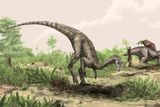The discovery of Nyasasaurus, which lived approximately 243 million years ago during the Middle Triassic, marks a significant milestone in paleontology as it is recognized as the oldest known dinosaur. Unearthed in Tanzania over a decade ago, this dinosaur stood about 3 feet tall and weighed between 45 and 135 pounds. The existence of Nyasasaurus highlights the evolutionary journey that led to the dominance of dinosaurs on Earth.
The Context of Nyasasaurus’ Era
Nyasasaurus thrived during a time when all continents were merged into the supercontinent Pangea. This unique geological arrangement created distinct ecosystems that would shape the evolution of early dinosaurs. According to David Lovelace, a vertebrate paleontologist at the University of Wisconsin Geology Museum, the Triassic period was characterized by a humid climate, but it was also a time of great environmental change.
During the early Triassic, the landscape was relatively flat, with few elevations compared to today’s mountainous regions. The land was dominated by pine trees, ferns, and cycads, as pollen and leaf fossils indicate. The transition into the Carnian Pluvial Episode saw volcanic activity lead to significant climate changes, resulting in intense rainfall for over a million years. This shift transformed arid deserts into lush environments, fostering diverse life forms.
The Evolutionary Path of Dinosaurs
Nyasasaurus lived alongside giant amphibians known as Temnospondylis, which could reach lengths of up to 10 feet. These creatures inhabited freshwater environments, showcasing the rich biodiversity of that era. Furthermore, early dinosaurs evolved from a group called archosaurs, which includes modern birds and crocodiles. This evolutionary lineage eventually led to over 700 species of non-avian dinosaurs.
Most early dinosaur fossils have been discovered in the Southern Hemisphere, with notable finds in regions such as present-day Wyoming and Morocco. For instance, a dinosaur species known as Ahvaytum bahndooiveche, which lived around the same time as Nyasasaurus, has been identified in North America. This small, chicken-sized dinosaur had a long tail and neck, showcasing the diversity of early dinosaur life.
Initially, early dinosaurs were primarily carnivorous or omnivorous, adapting to their environments by consuming whatever food sources were available. Over time, these species diverged into the recognizable herbivores and carnivores we associate with dinosaurs today, including the large, long-necked sauropods.
Geological Factors Influencing Discoveries
The predominance of dinosaur remains in the Southern Hemisphere can be attributed to the geological age of the rocks available for excavation. According to Lovelace, the late Triassic rocks in North America are generally younger, complicating efforts to locate fossils from the period when Nyasasaurus lived. In Europe, older rocks are often submerged underwater, further limiting discoveries.
As paleontologists continue to explore various regions of the globe, including areas previously overlooked, it is likely that older dinosaur specimens will emerge, offering new insights into the evolutionary history of these remarkable creatures.
This ongoing research underscores the importance of understanding the complex interplay between geology, climate, and evolution in the development of life on Earth. The story of Nyasasaurus and its contemporaries continues to inspire curiosity and deepen our understanding of the ancient world.
“The land at the beginning of the Triassic was relatively flat with slight bumps where the Rocky Mountains are now,” says Lovelace, emphasizing the dramatic changes that have occurred over millions of years.
For more detailed information on this topic, peer-reviewed studies and high-quality sources, including articles from Biology Letters and the Natural History Museum, provide credible insights into the origins and evolution of dinosaurs.






































































